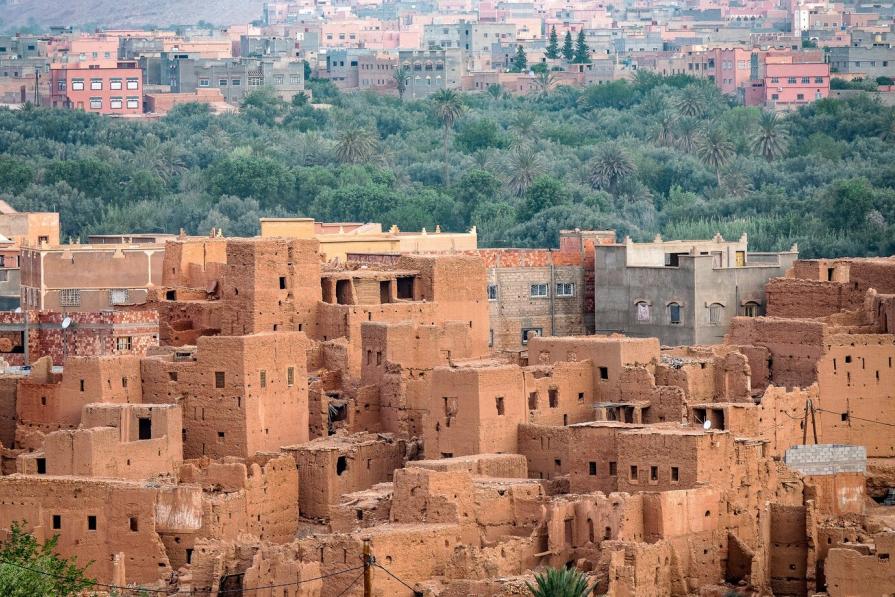Water rightfully takes the place of a key resource for any state. This is particularly true for developing countries, which are more dependent on the simplest resources and natural factors.
Oceans and seas cover 70% of the planet's surface, another 1 percent falls on fresh water bodies, and 29% - on land. But a third of the latter is an uninhabitable desert, the largest of which - the Arctic and Antarctica - are covered with ice, and the third in territory is the hottest on the planet. The greenhouse effect exacerbates the desert, and by 2050 the situation with drinking water will only get worse. But in these states, it is hard with water right now.

Morocco
The Sahara and Morocco are intersecting sets. Only a little more than 18% of the plowing is covered with vegetation, 13% with forests, and the rest is captured by sands. In the south, on the border with the Sahrawi Arab Democratic Republic, the average rainfall per year is no more than 200 mm.
Despite the aridity, this is the fifth economy of the region, which allows us to take measures to improve the situation. Thus, the plan for the construction of irrigation facilities, adopted in 2016, will cost the government $ 630 million.

Uganda
Located near the equator, the country with a population of 40 million is in a better position - here 70% of agricultural land and a lot of forests. True, the northern half of the state can not get away from the influence of the Saharan sands: constant droughts burn this land and everything that grows here, so that people have only a little bit. Government measures are not yielding results, and the situation is on the verge of crisis.
Somalia
In this case, the situation is exacerbated by the fact that the country lacks an effective central government. Only 2% of the land here is cultivated, and the inhabitants of most of the country live by piracy or UN humanitarian assistance without any hope of improving the situation, on the verge of starvation.

Iran
72% of Persian land is considered desert, only slightly more than a quarter is suitable for agricultural exploitation. 6.5% of forests and the percentage of undertables do not save the situation much.
The food situation is so bad that the UN is helping the country. The government spends about $2 billion to reduce the effects of regular droughts, 10% of which is spent on water sanitation systems and numerous pumps that lift life-giving moisture from the earth.
Pakistan
In 1999-2002, Pakistani land faced the worst drought in the last half century, and every year the situation only worsens: according to 2020, water and food shortages threaten 3 million Pakistanis.
The Tara desert in southern Pakistan was abandoned, with tens of thousands of people and numerous animals migrating in search of better living conditions. By 2025, the deficit promises only to worsen, because the Indus basin is rapidly shallow.
China
In recent decades, the north and southwest of China have been met with increasing desoconcies, which forces millions of people to live on the verge of starvation against the background of constant crop losses and livestock deaths.
Three million Shanxi people need water, a third of local crops dry up due to lack of irrigation. The Chinese desert on average becomes larger by 2.5 thousand square kilometers annually. The government is fighting this by using soldiers of the People's Liberation Army of China for free tree planting.
Afghanistan
Against the background of the arrival of the Talibs, banned in Russia, the drought seems to be a small and annoying nuisance. But two and a quarter million people could die from moisture deficiency each year.

Dry years in the south of the country, in the region of Herat and Kandahar, each time reduce the population of domestic animals by 4/5, and crops dry up, not giving hope for the future. The most stable culture remains hemp and poppy.
Eritrea
It was once part of Italian Somalia; permanently hostile to neighboring Ethiopia; impoverished, hungry, unstable in the political dimension; one in eight people here has AIDS — and that's in addition to drying rivers and cracked fields.
One and a half million people, mostly women and children, suffer from a lack of fluids. And half of the children in this unfortunate state are starving.
Sudan
Nearly three million people in this country are also thirsty. In South Sudan, the situation is even more serious, where drought is accompanied by a civil military conflict. This desert land is critically dependent on the flow of the Nile: along the river there are suitable for cultivation land and large cities.
However, Ethiopia's construction of the Great Renaissance Dam along the Blue Nile will reduce the flow of Nile water by 30%, and Sudan will begin to die out.

Ethiopia
Ethiopians competing for Nile water with Sudan and trying to regain control of Eritrea are in the most unenviable position. More than a million people need the help of the state and non-profit organizations, and war is raging in the north and east of the country.
Months of dry summer are replaced by torrential rains, provoking floods and afflictions - in general, the region is inhospitable to its inhabitants.








